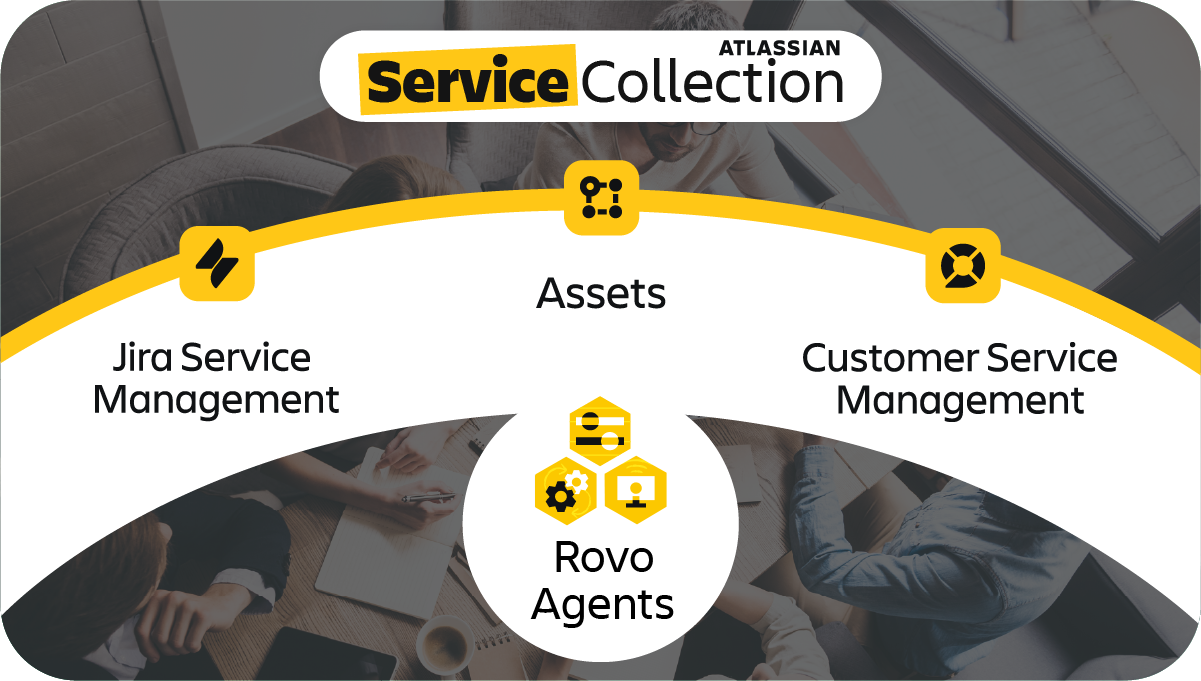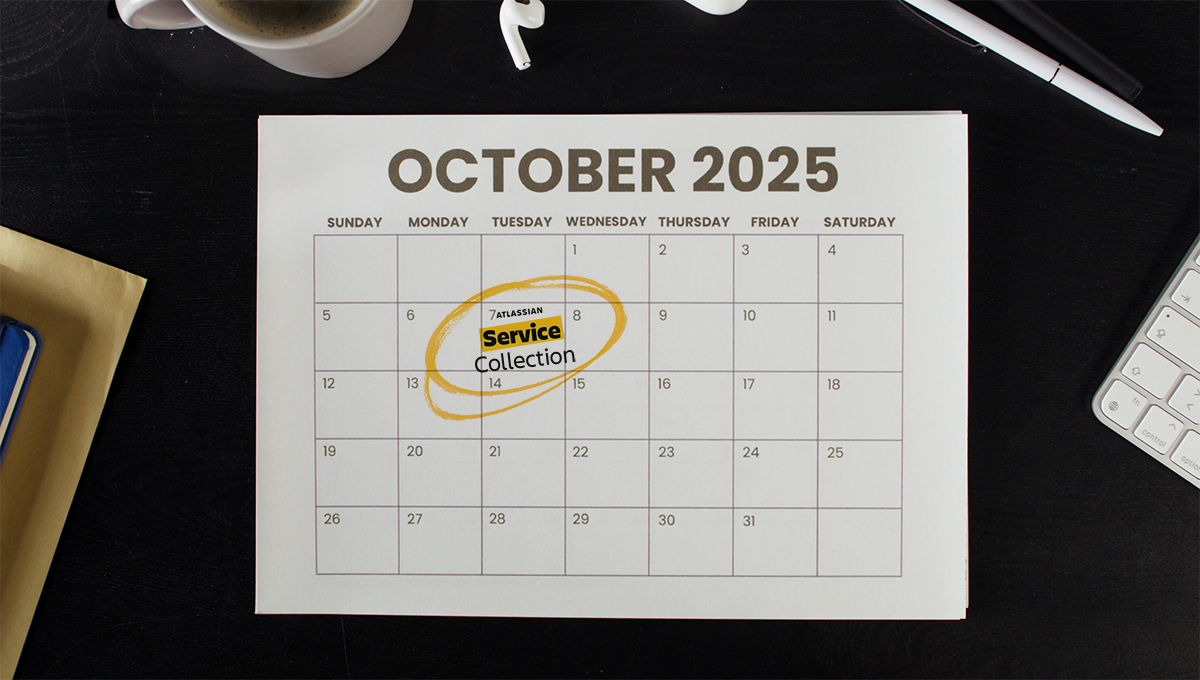
Help faster, work smarter, delight sustainably
Imagine 60% of the support requests in your company resolving themselves – without any manual effort. Starting October 7, 2025, Atlassian is taking a big step into the future of service management: the Service Collection. This new product bundle brings together Jira Service Management (JSM), the brand-new Customer Service Management (CSM) app, Assets, and Rovo Agents into a unified, AI-powered platform. For companies, that means faster processes, more seamless collaboration, and a future-proof solution for both internal and external service.
What’s behind the Service Collection ?
The idea is simple: Service management is no longer an isolated discipline. Employees expect smooth internal services, customers expect quick and helpful answers, and IT departments are under pressure to keep systems stable. With the Service Collection, Atlassian brings these worlds together.
- Jira Service Management (JSM): Your IT teams save up to 10 hours/week – because standard requests like password resets are already resolved automatically in the service portal.
- Customer Service Management (CSM): Customers get a response in real time—before they even have a chance to get impatient: the AI prioritizes requests and routes them directly to the right agent!
- Assets: No more guesswork during incidents: the flexible database for assets, services, and dependencies—so your teams can solve problems up to 4x faster!
- Rovo Agents: Your employees work on strategic topics while the AI handles routine questions—and even creates knowledge articles on its own.
The goal: a comprehensive tool that breaks down knowledge silos, internally and externally, even more efficiently—and makes work noticeably easier for everyone involved!
And what exactly is the benefit for us ?
The demands on service quality are steadily increasing. While it was previously possible to offer high-quality service with JSM alone, CSM and AI support now free up resources for the truly complex service requests. Here, customers automatically receive answers to the most common inquiries.
- Better customer experiences: CSM strengthens external support. Customer inquiries no longer pile up due to their volume; instead, they are routed directly to the right contacts based on their complexity.
- Closer collaboration: Feedback from the frontline reaches development and product management in real time. This enables faster implementation of improvements.
- More stable services: With Assets, dependencies can be clearly mapped. Critical systems can thus be monitored proactively and incidents resolved faster.
- More efficiency through AI: Rovo Agents take over routine work so that employees can focus on more complex topics.
In short: fewer friction losses, more focus on what really matters – the service for your customers and employees.
Example from the field
A medium-sized company with a few hundred employees and a small IT department:
- Recurring daily requests: “Screen broken”, “Forgot password”, “VPN not working”.
- Most requests are routine cases and cost IT valuable time.
- With JSM alone, there is often a lack of oversight (who uses which systems, what the configuration is, etc.).
Service Collection:
- Jira Service Management (JSM):
- Employees report their IT issues and requests through a service portal
- Standard processes, such as resetting a password, will run fully automatically going forward
- Assets:
- Employees are recorded in the system including permissions, software licenses, and devices.
Example: An employee reports that their email access no longer works. Thanks to the mapping in Assets, IT can immediately see which device the employee has and which dependencies, such as a VPN, exist.
- Employees are recorded in the system including permissions, software licenses, and devices.
- Rovo Agents:
- Recurring routine requests are answered automatically by Rovo, e.g., with a link to a self-service article for resetting a password.
- Frequent requests can be turned by Rovo directly into knowledge base articles so that future requests can be resolved without requiring IT staff to get involved.
- Collaboration:
- All departments, from HR to Facility Management, can use the same platform.
Example: Onboarding a new employee → It’s no longer necessary to submit requests in three different systems for a laptop, access, and workspace preparation. This now happens automatically and with minimal effort
- All departments, from HR to Facility Management, can use the same platform.
Benefits:
- Employees get immediate help thanks to self-service articles.
- IT staff can focus on the complex topics – Rovo has their back!
- Integrating all services on one platform avoids duplicate work.
- Assets provide transparency into employees’ systems – groping in the dark is a thing of the past.

What will change as of October 7, 2025 ?
There are important changes for existing and new Atlassian customers:
- Jira Service Management is no longer available as a standalone purchase. Instead, it will be offered exclusively as part of the Service Collection.
- New customers will start directly with the Collection and automatically receive JSM, CSM, Assets, and optionally the Rovo Agents.
- Existing JSM customers will transition to the Collection during fiscal year 2026. The advantage: you will get the CSM app at no additional cost.
- Pricing remains stable: The Collection costs as much as JSM does today. In addition, prices for Assets have been reduced and the limits significantly increased – especially in the Enterprise edition (from 50,000 to 500,000 objects).
What stays the same?
- The familiar editions (Free, Standard, Premium, Enterprise) remain.
- Existing features in JSM do not change.
- Pricing remains the same – there are no additional costs due to CSM.
This means you can be confident: your previous investments and process advancements in Jira Service Management retain their value.
JSM vs. CSM
What’s the difference?
| Area | Jira Service Management (JSM) | Customer Service Management (CSM) |
| Positioning | IT Service Management (internal, IT, DevOps) | External customer support (customer service, helpdesk) |
| Core benefit | Stability of internal services, fast IT processes | Improved customer experiences & feedback loops |
| Portals & tickets | Customer and employee portals, email support | Same basic functions, plus AI deflection & intelligent routing |
| Collaboration | Focus on IT teams & incident management | Bridge between Support, IT Ops, Dev & product management |
| AI support | Automations, basic AI (reply suggestions) | Rovo Agents: AI-powered ticket deflection, triage, knowledge articles |
| Assets integration | Yes, for IT & infrastructure | Yes, additionally for service processes with customer context |
| Licensing model | Previously available standalone | Only available in the new Service Collection |
| Target group | IT departments, internal services | Companies with a strong focus on end-customer support |
The biggest step:
Customer Service Management (CSM)
The biggest and probably most promising change in the new module is Customer Service Management. This marks Atlassian’s official entry into external customer support. Companies can now have their support teams work more easily on the same platform as their internal IT or DevOps teams.

That brings several advantages at once:
- Faster problem resolution: Support staff see the context of a request immediately and can provide more targeted help.
- Better collaboration on incidents: IT staff and Support exchange information in real time.
- Direct feedback to development: Bugs or feature requests end up with the responsible team without detours.
- Customer-centric product development: Feedback flows into the product cycle in a structured way.
- Automated article creation: With the help of the Rovo Agents, it is possible to have articles for the knowledge base written automatically.
Especially for companies that have so far worked with separate systems for customer service and IT, this opens up entirely new potential by allowing focus on the truly complex tasks.
Why Atlassian is taking this path
Atlassian has pursued the vision for years of making teams more efficient through smart collaboration. The Service Collection continues this vision consistently.
Instead of individual tools that exist side by side, a platform with all the necessary integrations is emerging:
- Planning, development, operations, and support flow seamlessly into one another and enrich each other with knowledge.
- AI supports not only solving tickets, but also preventing problems.
- Companies can respond faster to market demands – an essential competitive advantage.
What does this mean for you as a customer?
- If you already use JSM: you will gain access to CSM at no additional cost and benefit from better Assets terms.
- If you’re just getting started: you’ll get the full package from day one – and start with a solution that covers both internal IT service and external customer service.
- If you have to pay attention to compliance: there is a clear roadmap for how and when regulated environments will be migrated.
One thing is clear: the Service Collection is not just a new product, but the new standard for service management with Atlassian.
Our conclusion
With the Service Collection, Atlassian is making service management fit for the future. For companies, this means less complexity, more performance, and tight integration between internal IT service and external customer support.
If you’re already using Jira Service Management today, there’s no need to worry: the transition is planned and brings additional benefits. If you’re starting fresh, you’ll get a solution that covers everything important from the start – and works even more efficiently thanks to AI support.
The Service Collection is more than an update – it’s your springboard for next-generation service management. Let’s take off together!